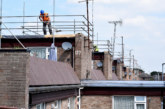Research into cavity wall insulation in social housing and private homes in Northern Ireland has been published. The research was commissioned in 2017 by the Housing Executive on the back of concerns about the standard of cavity wall insulation in its own properties.
The research was carried out by Consultancy, Investigation and Training (CIT) a subsidiary of the British Board of Agrément (BBA), the UK’s leading construction certification body, offering approval, certification, audit and test services to manufacturers of products and systems in the built environment. A sample of more than 800 Housing Executive properties and 100 privately owned homes were surveyed as part of the research.
The research found that of the Housing Executive stock surveyed, 63% had cavity wall insulation, which was non-compliant with current industry standards leaving 37% compliant. This means that voids and/or debris in the cavity have been identified. Additionally, it was discovered that for 1% of properties surveyed, their external façade had deteriorated and the internal fabric had been compromised; 32% had building fabric that had been compromised but the situation was stable and 51% had minimal building fabric defects with no serious underlying causes. Sixteen percent of the stock was found to be defect-free.
In contrast, of the private homes surveyed, 36% had cavity wall insulation installations that were non-compliant with current industry standards, leaving 64% compliant. Similar to the Housing Executive homes, for 1% of properties surveyed their external façade had deteriorated and the internal fabric had been compromised; 15% had building fabric that had been compromised but the situation was stable and 43% had minimal building fabric defects with no serious underlying causes. Forty-one percent of the stock was found to be defect-free.
CIT has made a number of recommendations including prioritising remediation work; training Housing Executive staff; setting industry standards for suppliers; seeking compensation from companies responsible for non-compliant installations and establishing mechanisms for tenants to raise concerns related to cavity wall insulation in their homes.
Rob McCormack, CIT Director, said: “CIT believes its recommendations address the issues of remediation across the Housing Executive’s social housing stock as well as suggesting ways to ensure repair work is carried out in full compliance with cavity wall insulation industry standard.
“This research will allow the Housing Executive to use fact-based evidence and robust methodology to assess its remaining housing stock, identify those homes in most urgent need of remediation and efficiently plan maintenance programmes to address the issues identified. The research is also intended to inform future strategy that will allow the Housing Executive to lead the way in developing housing and insulation policy based on strong, operational evidence in the field.”
A spokesperson for the Housing Executive commented: “We carried out an extensive programme of insulating cavity walls in the 1980s and 1990s. However, like many other UK social housing providers we have been increasingly concerned by nationwide reports of cavity wall insulation no longer performing as required due to degradation or poor installation.
“In 2013 we commissioned a small research project which surveyed 206 properties and found that the cavity wall insulation had deteriorated in many of the properties. Following continued concerns by tenants, elected representatives and the insulation industry about cavity wall insulation failure and, together with the 2015 stock condition survey by Savills that identified significant investment requirements for our stock, we decided to commission a larger investigation in order to provide us with robust information on the extent, the type and reasons for cavity wall insulation failure in our stock. As part of the House Condition Survey that we conduct, we also examined homes in the private sector.
“We thank CIT for their work in what is the largest research project of its kind that we are aware of across the UK. We will now consider CIT’s findings and recommendations and consult stakeholders. In the short-term, we will, of course, immediately focus on those properties in which CIT has indicated a specific need for urgent remedial work. Later this year we will bring forward a longer-term strategy and plan for addressing the broader issues that have been identified.
“However, such a strategy and plan will have to be prioritised against the many other significant investment needs for our housing stock — such as our Tower Blocks Action Plan — improving the thermal performance of our non-traditional dwellings and addressing the maintenance backlog in external improvements and the replacement of kitchens and bathrooms. These will be important decisions and will be made in the context that we are still projecting a significant shortfall in the funding required to achieve and maintain our housing stock at a modern standard. Once again this brings into sharp focus the need to secure a sustainable funding model for the Housing Executive, particularly with regard to access to external borrowing.
“We acknowledge there have been many energy improvement measures undertaken across our stock over the years, in terms of our double glazing programme and heating upgrades. The findings of this research will now be used to complement our forthcoming 10-year energy strategy.”









